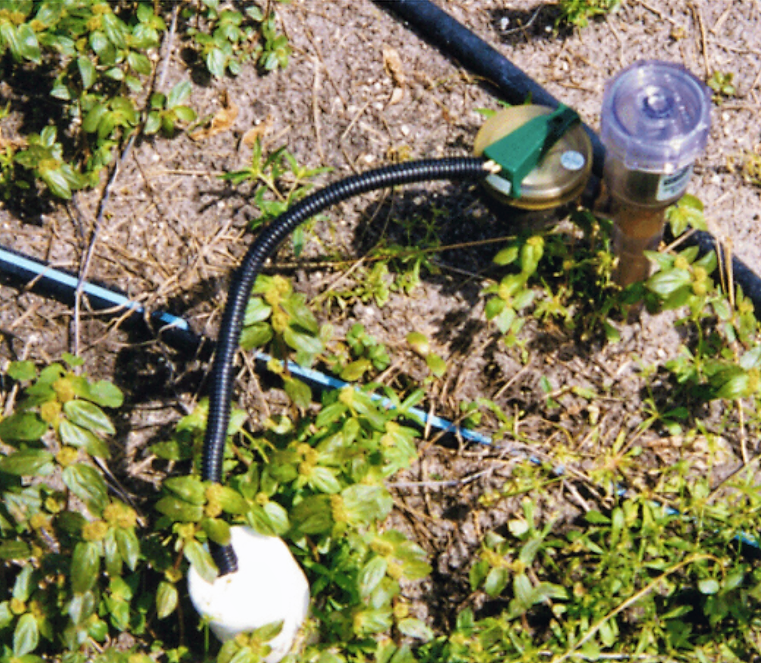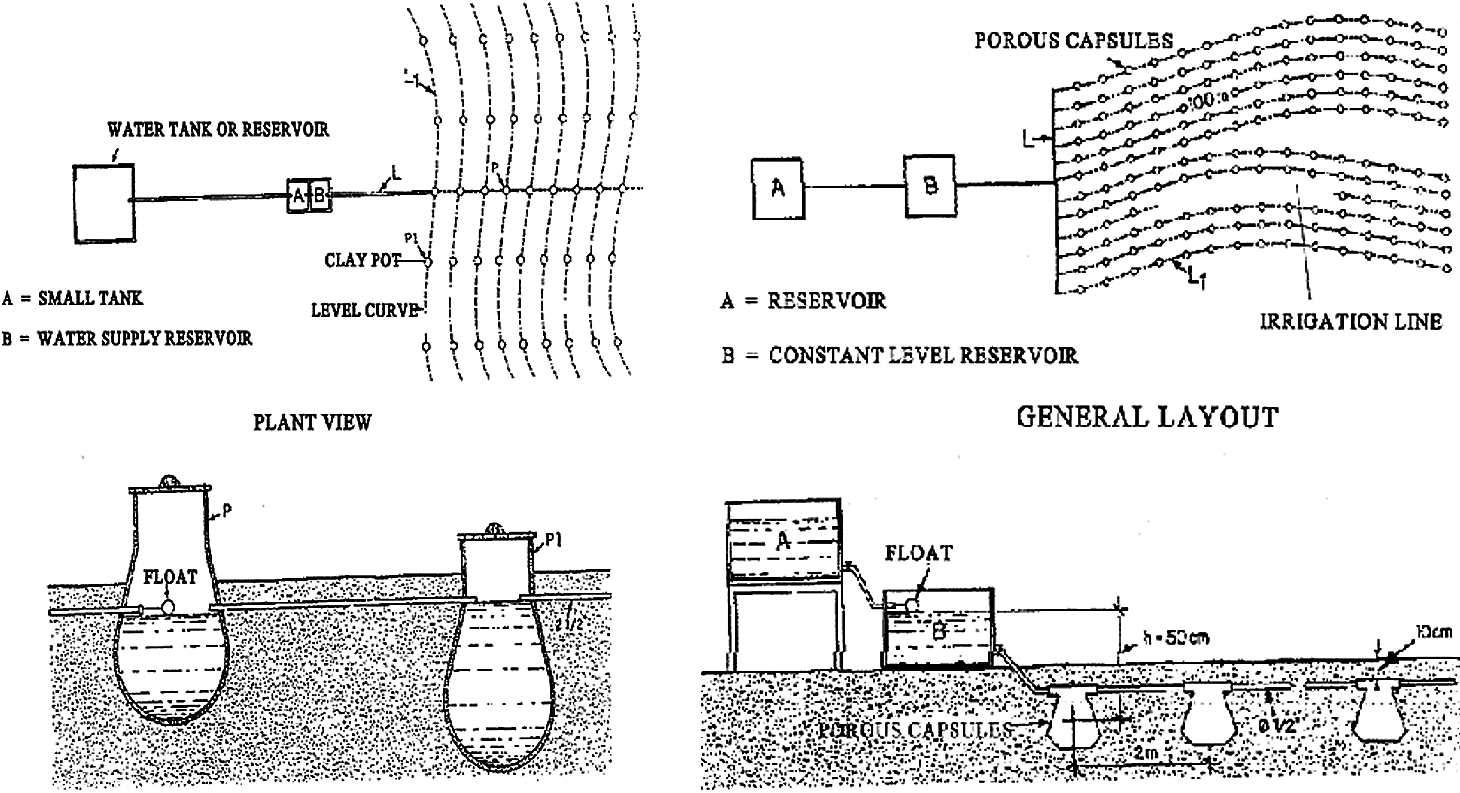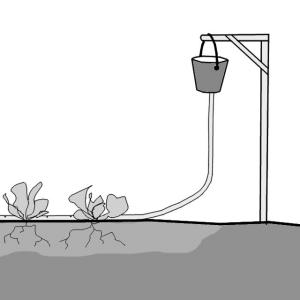Executive Summary
An automated irrigation system refers to the operation of the system with no or just a minimum of manual intervention beside the surveillance. Almost every system (drip, sprinkler, surface) can be automated with help of timers, sensors or computers or mechanical appliances. It makes the irrigation process more efficient and workers can concentrate on other important farming tasks. On the other hand, such a system can be expensive and very complex in its design and may needs experts to plan and implement it.
| In | Out |
|---|---|
Food Products |
Introduction
An automation of irrigation systems has several positive effects. Once installed, the water distribution on fields or small-scale gardens is easier and does not have to be permanently controlled by an operator. There are several solutions to design automated irrigation systems. Modern big-scale systems allow big areas to be managed by one operator only. Sprinkler, drip or subsurface drip irrigation systems require pumps and some high tech-components and if used for large surfaces skilled operators are also required. Extremely high-tech solutions also exist using GIS and satellites to automatically measure the water needs content of each crop parcel and optimise the irrigation system. But automation of irrigation can sometimes also be done with simple, mechanical appliances: with clay pot or porous capsule irrigation networks or bottle irrigation (see also manual irrigation).
High-Tech Principles
Automation of irrigation systems refers to the operation of the system with no or minimum manual interventions. Irrigation automation is justified where a large irrigated area is divided into small segments called irrigation blocks and segments are irrigated in sequence to match the discharge available from the water source. There are six high-tech automation systems, which are described below.
Time Based System
Irrigation time clock controllers, or timers, are an integral part of an automated irrigation system. A timer is an essential tool to apply water in the necessary quantity at the right time. Timers can lead to an under- or over-irrigation if they are not correctly programmed or the water quantity is calculated incorrectly (CARDENAS-LAILHACAR 2006). Time of operation (irrigation time – hrs per day) is calculated according to volume of water (water requirement - litres per day) required and the average flow rate of water (application rate – litres per hours). A timer starts and stops the irrigation process (RAJAKUMAR et al. 2008 and IDE n.y.).
Volume Based System
The pre-set amount of water can be applied in the field segments by using automatic volume controlled metering valves (RAJAKUMAR et al. 2008). An example for a volume based irrigation method is described in ZELLA et al. (2008).
Open Loop Systems
(Adapted from BOMAN et al. 2006)
In an open loop system, the operator makes the decision on the amount of water to be applied and the timing of the irrigation event. The controller is programmed correspondingly and the water is applied according to the desired schedule. Open loop control systems use either the irrigation duration or a specified applied volume for control purposes. Open loop controllers normally come with a clock that is used to start irrigation. Termination of the irrigation can be based on a pre-set time or may be based on a specified volume of water passing through a flow meter.
Closed Loop Systems
(Adapted from BOMAN et al. 2006)
In closed loop systems, the operator develops a general control strategy. Once the general strategy is defined, the control system takes over and makes detailed decisions on when to apply water and how much water to apply. This type of system requires feedback from one or more sensors. Irrigation decisions are made and actions are carried out based on data from sensors. In this type of system, the feedback and control of the system are done continuously. Closed loop controllers require data acquisition of environmental parameters (such as soil moisture, temperature, radiation, wind-speed, etc) as well as system parameters (pressure, flow, etc.).

Real Time Feedback System
With this application irrigation is based on actual dynamic demands of the plant itself; the plant root zone is effectively reflecting all environmental factors acting on the plant. Operating within controlled parameters, the plant itself determines the degree of irrigation required. Various sensors, tensiometers, relative humidity sensors, rain sensors, temperature sensors etc. control the irrigation scheduling. These sensors provide feedback to the controller to control its operation (RAJAKUMAR et al. 2008).
Computer Based Irrigation Control Systems
A computer-based control system consists of a combination of hardware and software that acts as a supervisor with the purpose of managing irrigation and other related practices such as fertigation and maintenance. Generally, the computer-based control systems used to manage irrigation systems (e.g. drip irrigation systems) can be divided into two categories: interactive systems and fully automatic systems. Read more about it in RAJAKUMAR et al. (2008).

Besides these high-tech solutions there are also effective methods without any energy supply. Optimising a system mechanically with the help of gravity can automate an irrigation process. Examples are the small-scale and self-made drip irrigation systems described here or the systems described below.
Low-Tech Principles
Clay Pot and Porous Capsule Irrigation Network
(Adapted from UNEP 1998)
This old system has been modernised and reapplied in water scarce areas. The technology consists of using clay pots and porous capsules (see also pitcher irrigation) to improve irrigation practices by increasing storage and improving the distribution of water in the soil. This low-volume irrigation technology is based on storing and distributing water to the soil, using clay pots and porous capsules interconnected by plastic piping. A constant-level reservoir is used to maintain a steady hydrostatic pressure. Clay pots are open at the top and are usually fired in home furnaces after being fabricated from locally obtained clay or clay mixed with sand. The pots, usually conical in shape and with a capacity of 10 to 12 litres, are partially buried in the soil with only the top poking out. Distribution is done by plastic (PVC) piping to ensure a fairly uniform permeability and porosity. Maintaining a constant level in the storage reservoir regulates hydrostatic pressure.

A similar system, tested in Mexico and Brazil, uses smaller, closed containers, or porous capsules, completely buried in the soil. These containers distribute the water either by suction and capillary action within the soil, or by external pressure provided by a constant-level reservoir (as in the previous system). Each capsule normally has two openings to permit connection of the plastic (PVC) piping which interconnects the capsules. The capacity of these capsules ranges between 7 and 15 litres, and the storage tanks supplying the system are elevated 1 or 2 m above the soil surface. The capsules are buried in a line 2 meters apart, at least 10 cm under the top layer of the soil. The number of pots or capsules used is a function of the area of cultivation, soil conditions, climate, and pot size. Up to 800 pots/ha were installed in Brazil.
Automatic Surge Flow and Gravitational Tank Irrigation System
This is an intermittent gravity-flow irrigation system. It has been used almost exclusively for small-scale agriculture and domestic gardening. Prior to the development of this technology, electronically controlled valves were used to produce intermittent water flows for irrigation. These valves are expensive and require some technical training to operate. The siphon replaces these valves with a device that would be more cost-effective and easier to operate and maintain with a minimum consumption of energy. The system consists of a storage tank equipped with one or more siphons (see figure below) (UNEP 1998). The water in the tank flows to the field because of the siphon effect. As soon as the tank is empty, the flow stops. For the next irrigation process, the tank has to be filled-up to restart the siphon effect again. To learn more about possible siphon designs see VORTECH (2009).

Another system that produces similar results is the use of a storage tank with a bottom discharge. It is equipped with a floater, which allows the cyclical opening and closing of a gate at the bottom of the tank. In effect, the operation of the floater is similar to the mechanism in the storage tank of a toilet flushing system. The materials normally used in the construction of the water storage tanks are gravel and cement, reinforced concrete or plastic. The siphons are usually built of a flexible plastic material; PVC is not recommended (UNEP 1998).
Cost Considerations
Costs highly depend on the applied system. It varies from very cheap (e.g. timer) to very expensive systems, which includes research on soil quality and technical material.
Operation and Maintenance
Automatic irrigation systems need to be operated by skilled labourers and maintained frequently. Malfunctions of sensors and valves have to be avoided at all cost and common repair work (e.g. leaches, blockages) has to be considered as well.
At a Glance
| Working Principle | The irrigation system is either mechanically or electronically automated. This allows for very efficient irrigation. |
| Capacity/Adequacy | Every irrigation system can be automated rendering it more efficient. |
| Performance | High |
| Costs | Depends on the size of the irrigation system and the degree of automation. From very small- (timer which activates the valve) to big-scale systems (e.g. real time feedback system). |
| Self-help Compatibility | Expert design is required for commercial systems. A small-scale system (e.g. time based) can be installed by the farmer. |
| O&M | These systems need to be operated by skilled labourers and maintained frequently. They also require thorough surveillance. The proper functioning of sensors and valves as well as common repair work (e.g. leaches, blockages) has to be considered. |
| Reliability | Very reliable if operated and maintained well. |
| Main strength | High water application efficiency. |
| Main weakness | Complex designs can be expensive. |
Almost every irrigation system can be automated. It makes sense in every region of the world as it saves time and water. Furthermore, high-tech designs allow for very efficient irrigation i.e. metering the water volumes more precisely. Once the system is optimised, labourers do not have to worry about the irrigation process and can concentrate on more important tasks.
Control and Automation in Citrus Microirrigation Systems
Microirrigation (drip and microsprinklers) is the predominant method for irrigation of citrus in Florida. With chemigation, microirrigation systems can also provide an economical method of applying fertiliser and other agricultural chemicals on a timely basis. However, microirrigation systems require a higher level of management expertise than other irrigation methods. Microirrigation systems are more complex, require greater filtration and water treatment, and typically have high maintenance costs compared to other types of irrigation.
BOMAN, B. SMITH, S. TULLOS, B. (2006): Control and Automation in Citrus Microirrigation Systems. Gainesville: University of Florida URL [Accessed: 07.05.2019]Sensor-Based Automation of Irrigation of Bermudagrass
Technical Manual for Ideal Micro Irrigation Systems
This manual features comprehensive parts lists and instructions for assembling low-cost drip irrigation systems.
IDE (n.y): Technical Manual for Ideal Micro Irrigation Systems. Golden: International Development Enterprises URL [Accessed: 07.05.2019]Automation in Micro-Irigation
Source Book of Alternative Technologies for Freshwater Augmentation in Latin America and the Caribbean
The Latin American and Caribbean countries have seen growing pressure on water resources, with increasing demand and costs, for agricultural, domestic and industrial consumption. This has brought about the need to maximize and augment the use of existing or unexploited sources of freshwater. There are many modern and traditional alternative technologies for improving the utility and augmenting the supply of water being employed in various countries, but with limited application elsewhere due to the lack of information transfer among water resources managers and planners. This book was prepared to provide water resource managers and planners, especially in developing countries and in countries with economies in transition, with information on the range of technologies that have been developed and used in the various countries throughout the world.
UNEP (1998): Source Book of Alternative Technologies for Freshwater Augmentation in Latin America and the Caribbean. Nairobi: United Nations Environment Programme (UNEP) URL [Accessed: 17.10.2011]Super Siphon: Installation and Design Manual
This manual describes the siphon system of Vortech Ltd. It has no moving parts, requires no additional power input and its unique design offers direct benefits for the environment as well as savings on the installation, operating and maintenance costs.
VORTECH (2009): Super Siphon: Installation and Design Manual. Warkworth: Ashby Consulting Engineering Ltd. URL [Accessed: 27.10.2011]Design of a Micro-Irrigation System Based on the Control Volume Method
A micro-irrigation system design based on a control volume method using the back step procedure is presented in this study. The proposed numerical method is simple and consists of delimiting an elementary volume of the lateral equipped with an emitter, called “control volume” on which the conservation equations of the fluid hydrodynamics are applied.
ZELLA, L. ; KETTAB, A. ; CHASSERIAUX, G. (2006): Design of a Micro-Irrigation System Based on the Control Volume Method. In: Biotechnology, Agronomy, Society and Environment : Volume 10 , 163 – 171. URL [Accessed: 17.10.2011]Control and Automation in Citrus Microirrigation Systems
Microirrigation (drip and microsprinklers) is the predominant method for irrigation of citrus in Florida. With chemigation, microirrigation systems can also provide an economical method of applying fertiliser and other agricultural chemicals on a timely basis. However, microirrigation systems require a higher level of management expertise than other irrigation methods. Microirrigation systems are more complex, require greater filtration and water treatment, and typically have high maintenance costs compared to other types of irrigation.
BOMAN, B. SMITH, S. TULLOS, B. (2006): Control and Automation in Citrus Microirrigation Systems. Gainesville: University of Florida URL [Accessed: 07.05.2019]Automation in Micro-Irrigatio
This paper explains the different methods of an automated irrigation system and what components are needed.
RAJAKUMAR, D. RAMAH, K. RATHIKA, S. THIYAGARAJAN, G. (2008): Automation in Micro-Irrigatio. New Delhi: Technology Innovation Management and Entrepreneurship Information Service. [Accessed: 24.10.2011] PDFSource Book of Alternative Technologies for Freshwater Augmentation in Latin America and the Caribbean
The Latin American and Caribbean countries have seen growing pressure on water resources, with increasing demand and costs, for agricultural, domestic and industrial consumption. This has brought about the need to maximize and augment the use of existing or unexploited sources of freshwater. There are many modern and traditional alternative technologies for improving the utility and augmenting the supply of water being employed in various countries, but with limited application elsewhere due to the lack of information transfer among water resources managers and planners. This book was prepared to provide water resource managers and planners, especially in developing countries and in countries with economies in transition, with information on the range of technologies that have been developed and used in the various countries throughout the world.
UNEP (1998): Source Book of Alternative Technologies for Freshwater Augmentation in Latin America and the Caribbean. Nairobi: United Nations Environment Programme (UNEP) URL [Accessed: 17.10.2011]Super Siphon: Installation and Design Manual
This manual describes the siphon system of Vortech Ltd. It has no moving parts, requires no additional power input and its unique design offers direct benefits for the environment as well as savings on the installation, operating and maintenance costs.
VORTECH (2009): Super Siphon: Installation and Design Manual. Warkworth: Ashby Consulting Engineering Ltd. URL [Accessed: 27.10.2011]Irrigation Practice and Policy in the Lowlands of the Horn of Africa
The drought of 2011 and the famine that followed in politically instable Somalia highlighted the vulnerability of the lowlands of the Horn of Africa. It is a story revisited with high frequency – 2000, 2005, and 2008. Climate variability is easily mentioned as the main attributing factor. Clearly it is – but there is also extensive land use change, because of the widespread invasion of invasive species (prosopis in particular) and the decimation of natural wood stands for charcoal production (particularly in Somalia). 2011 was a crisis year – but even in a normal years food insecurity is common. In the Afar lowlands in Ethiopia food aid has become part of the livelihoods, with most of the people dependent on it – including reportedly middle class families. There is a growing realization that water resource development – appropriate to the context – has to have a place in addressing food insecurity in the Horn of Africa. This paper focuses on irrigation policy and practice in the arid lowlands of the Horn that have been hit hardest and most frequent in the drought episodes
ALEMEHAYU, T. DEMISSIE, A. LANGAN, S. EVERS, J. (2011): Irrigation Practice and Policy in the Lowlands of the Horn of Africa. Rome: Food and Agriculture Organization of the United Nations (FAO) URL [Accessed: 26.03.2012]PC-Based Automation of a Multi-Mode Control for an Irrigation System
This paper describes the design and implementation of a low-cost multi-mode control for an irrigation system built around a personal computer (PC). The system uses in-situ soil water potential measurements, the weather condition parameters and the set points data provided by the user to decide when and how much water to apply to the irrigated field.
BENZEKRI, A. ; MEGHRICHE, K. ; REFOUFI, L. (2007): PC-Based Automation of a Multi-Mode Control for an Irrigation System. In: Industrial Embedded Systems: , 310-315. URL [Accessed: 24.10.2011]Evaluation of the Effectiveness of an Automated Irrigation System Using Wheat Crops
Water stress continues to be one of the most significant environmental factors affecting growth, production and quality of crops worldwide. Improving water agricultural efficiency is crucial in many parts of the world, especially in arid and semi-arid regions, such as Saudi Arabia. The current study investigates the use of an automated irrigation system in comparison with manual irrigation.
BOUTRAA, T. AKHKHA, A. ALSHUAIBI, A. ATTA, R. (2011): Evaluation of the Effectiveness of an Automated Irrigation System Using Wheat Crops. Milford: AGRICULTURE AND BIOLOGY JOURNAL OF NORTH AMERICA URL [Accessed: 24.10.2011]Evaluation Of Evapotranspiration-Based and Soil-Moisture based Irrigation Control in Turf
This study compares two types of commercially available irrigation control technologies, one based on estimates of evapotranspiration and the other based on feedback from soil moisture sensors.
GRABOW, G.L. VASANTH, A. BOWMAN, D. HUFFMAN, R.L. MILLER, G.L. (2008): Evaluation Of Evapotranspiration-Based and Soil-Moisture based Irrigation Control in Turf. Ahupua'a: World Environmental and Water Resources Congress 2008 URL [Accessed: 07.05.2019]GIS-Based Decision Support System for Real Time Water Demand Estimation in Canal Irrigation Systems
This study presents a scheme for the development of a Geographic Information Systems (GIS) based decision support system (DSS) for real time water demand estimation in distributaries.
RAO, N.H. ; BROWNEE, S.M. ; SARMA, P.B.S. (2004): GIS-Based Decision Support System for Real Time Water Demand Estimation in Canal Irrigation Systems. In: Current Science: Volume 87 , 628-636. URL [Accessed: 07.05.2019]Automation of Irrigation System Using ANN Based Controller
This paper presents Artificial Neural Network (ANN) based intelligent control systems for effective irrigation scheduling. The proposed ANN based controller is prototyped using MATLAB. The input parameters like air temperature, soil moisture, radiation and humidity are modelled. Then, using appropriate methods, ecological conditions, evapotranspiration and type of crop, the amount of water needed for irrigation is estimated and then associated results are simulated.
UMAIR, S.M. ; USMAN, R. (n.y): Automation of Irrigation System Using ANN Based Controller. In: International Journal of Computer and Electrical Engineering (IJCEE): Volume 10 , 45-51. URL [Accessed: 24.10.2011]Design of a Micro-Irrigation System Based on the Control Volume Method
A micro-irrigation system design based on a control volume method using the back step procedure is presented in this study. The proposed numerical method is simple and consists of delimiting an elementary volume of the lateral equipped with an emitter, called “control volume” on which the conservation equations of the fluid hydrodynamics are applied.
ZELLA, L. ; KETTAB, A. ; CHASSERIAUX, G. (2006): Design of a Micro-Irrigation System Based on the Control Volume Method. In: Biotechnology, Agronomy, Society and Environment : Volume 10 , 163 – 171. URL [Accessed: 17.10.2011]The Siphon
This short YouTube video shows how the siphon effect works.


